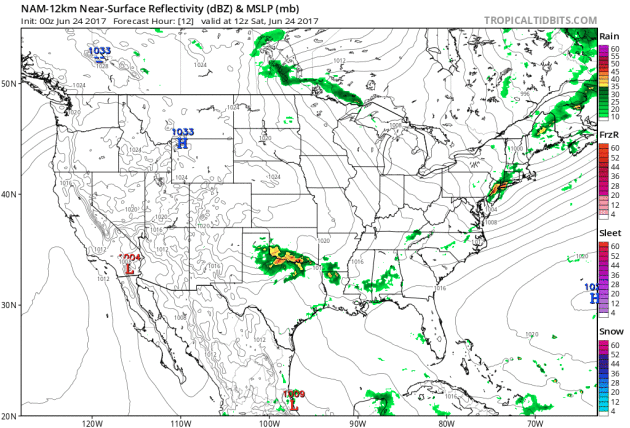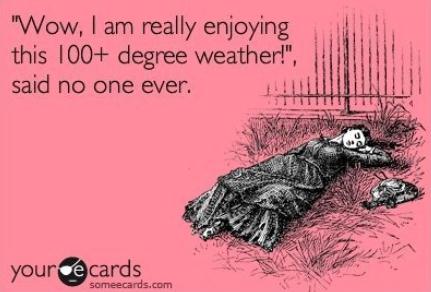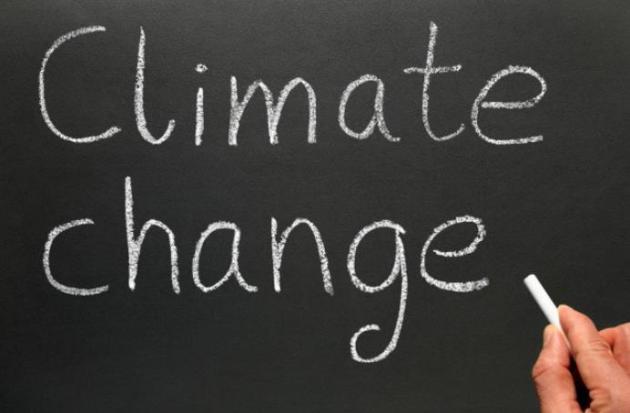81 F. average high on June 23.
77 F. high on June 23, 2016.
June 24, 2002: Heavy rains fall on already saturated ground, leading to flooding. 5.50 inches fall at Delano, and half of a mobile home park at Howard Lake is evacuated due to rising water.
June 24, 1972: Frost develops across northeast Minnesota. Duluth has a low of 35 and Tower bottoms out at 32.
In Search of June - Milder for 4th of July
What's the better option, extreme cold or debilitating heat? Would you rather be marooned in Antarctica, or a distant suburb of Hell? I ask this rhetorical question because my friends in Scottsdale have gone quiet in recent weeks. These are the same pals who text me photos from the golf course in January.
Minnesotans get their fair share of grief for winter chill, but at least we can walk our dogs year-round. The National Weather Service sent out a statement, warning that dogs and cats risk burns on their paws. Air temperatures were 115-125, but asphalt surface temperatures were closer to 160F, "the minimum safe temperature for cooking ground beef". Pick your poison.
Meanwhile the furnace has kicked on now; it feels like October out there with 60s this weekend and showers popping up each afternoon. Don't panic... yet.
Wednesday looks wet, but temperatures rebound next week and odds favor 70s for the 4th of July weekend, with the heaviest T-storms staying south of Minnesota. Better than the autumnal scene outside your window right now.
A welcome cool intermission from the summer muggies.
Spotty Rains Continue in Minnesota. Here's an excerpt of this week's Minnesota WeatherTalk from Mark Seeley: "This week brought some significant thunderstorms to portions of Minnesota, notably the northwest and the southern tier of counties near the Iowa border. Some northwestern observers reported a half inch or over an inch of rain, much needed given the heat and rapid growth of crops earlier in the month. Across southern counties rainfall of 1 inch to 1.50 inches was prevalent. Most other observers are reporting total monthly rainfall that falls short of normal. Only about 20 percent of the climate stations are reporting normal or greater than normal rainfall this month. Portions of Kittson, Marshall, Roseau, Lake of the Woods, Beltrami, and Koochiching Counties remain in moderate drought...."
Cool Bias Into Early June. The chilliest readings come this weekend, but I don't see us climbing out of this cool rut until the second week of July.


- The United States Border Patrol stepped up safety messages, saying "it is physically impossible for the average person to carry enough water to survive."
- The National Weather Service also warned against walking pets outdoors, saying that at pavement temperatures above 162 degrees (consistent with air temperatures of 102), skin is instantly destroyed.
Phoenix: Second-Fastest Warming City in the USA. Praedictix meteorologist Kristin Clark explains: "...In the U.S. Phoenix is the second-fastest warming city over the past 50 years. We are fortunate in the States to have access to cooling technologies. Yet the increasing frequency of heat waves will negatively impact health with more heat-related illnesses like heat exhaustion and heat stroke. Diseases could spread as insects thrive in newly warmed regions. More days with poor air quality will lead to asthma and poor respiratory health. Stresses on crops and worsening drought will impact agriculture. Elevated strains on the energy grid grow as demand for air conditioning increases. The use of energy increases as well as cooling costs. Hot how will it get at your house this week? Be sure to check the Praedictix local, regional and national forecast..."
File photo: Greater Phoenix Chamber of Commerce.
Map credit: "Based on the PHDI. PHDI is a primary measure of long-term drought but may not apply to all areas, including those with heavily managed surface water. No additional precipitation is needed for white areas. Values are in inches."
Warning System for Great Lakes Tsunamis Under Development. I had no idea - here's a clip from a fascinating article at MLive.com: "...Rapid changes in barometric pressure, often associated with fast-moving weather systems, can generate meteotsunamis. Although many meteotsunamis are too small to notice, large meteotsunamis can have devastating coastal impacts, including damaging waves, flooding and strong currents, that cause significant damage, injury and death. An average of 106 meteotsunamis are observed each year, according to the CIGRL. For example, in 2003 in Sawyer, seven people drowned in an incident initially attributed to rip currents, though the water level records indicated a moderate meteotsunami occurred around the time of the drownings..."
Photo credit: "A wave crashes over the pier at Pere Marquette Park in Muskegon Friday, Oct. 31, 2014." (Cory Morse | MLive.com).

File photo: Pixabay.com.
Photo credit: "In this June 2, 2014 file photo, cattle graze in a pasture near a wind turbine in Adair, Iowa. President Trump’s putdown of wind energy at his Iowa rally was denounced Thursday, June 22, 2017, across the state, which has been a national leader in wind generation. Trump was talking up his support for coal during his speech in Cedar Rapids on Wednesday when he said: “I don’t want to just hope the wind blows to light up your homes and your factories.” He added “as the birds fall to the ground,” a reference to birds killed by turbines." (AP Photo/Charlie Neibergall, File)
Fisticuffs Over The Route to a Clean-Energy Future. Could the U.S. economy run on entirely-renewable sources like wind, solar and hydro? Probably not with today's antiquated grid, reports The New York Times: "Could the entire American economy run on renewable energy alone? This may seem like an irrelevant question, given that both the White House and Congress are controlled by a party that rejects the scientific consensus abouut human-caused climate change. But the proposition that it could, long a dream of an environmental movement as wary of nuclear energy as it is of fossil fuels, has been gaining ground among policy makers committed to reducting the nation's carbon footprint. Democrats in both the United States Senate and in the California Assembly have proposed legislation this year calling for a full transition to renewable energy sources..."
New Solar Paint Could Offer Endless Supply of Clean Energy. This is the kind of potential breakthrough we're going to need to power up world economies without harmful pollution or greenhouse gas emissions. Fusion reports: "Researchers at RMIT University in Australia have developed a solar paint that could offer endless supplies of clean energy. The paint captures water vapor from the surrounding air, and then uses energy provided by the sunlight to split the water into hydrogen and oxygen. Once harvested, the resulting hydrogen could power fuel cells (which can provide electric power) or go directly into powering combustion engines..."
Photo credit: Pixabay.

Illustration credit: Francesco Francavilla for Fortune.
Senate Health Bill is a Disaster for Opioid Crisis. Wired.com reports.
Deadly Hemlock Emerging, Spreading in Parts of Minnesota. Here's an excerpt from Star Tribune: "Poison
hemlock is spreading in parts of southeastern Minnesota, prompting
warnings to avoid touching the toxic flowering weed and get immediate
emergency help if it's ingested. The weed, which is native to Europe and
brought to North America as an ornamental plant, can grow 8 feet tall
and has white clusters of flowers. It's now in bloom in parts of the
state and sometimes is mistaken for wild carrot or toxic water hemlock.
But poison hemlock can be differentiated from those two species because
it has fern-like leaves and purple blotches on the stems..."
Photo credit: Minnesota Department of Agriculture.

Illustration credit: Ignacio Serrano.
TODAY: Cool and showery - typical for early October. Winds: NW 10-20. High: 65
SATURDAY NIGHT: Showers taper, still chilly. Low: 52 (40s up north)
SUNDAY: What June? Some sun, cool wind and a stray shower. Winds: NW 10-20. High: 66
MONDAY: More sun, still refreshingly cool. Winds: NW 10-15. Wake-up: 49. High: 71
TUESDAY: Partly sunny, warmer breeze. Winds: S 10-20. Wake-up: 54. High: 79
WEDNESDAY: Humid, heavy showers and T-storms likely. Winds: S 10-20. Wake-up: 62. High: 81
THURSDAY: Some sun, probably a drier day. Winds: W 7-12. Wake-up: 63. High: 83
FRIDAY: Mix of clouds and sun, lukewarm. Winds: N 5-10. Wake-up: 65. High: near 80
Climate Stories....
From Heatwaves to Hurricanes, Floods to Famine: Seven Climate Change Hotspots. The Guardian takes a look at where the symptoms of a rapidly changing climate may have the most immediate implications: "...The evidence for the onset of climate change is compelling. But who and where is it hitting the hardest? How fast will it come to Africa, or the US? What will be its impact on tropical cities, forests or farming? On the poor, or the old? When it comes to details, much is uncertain. Mapping the world’s climate hotspots and identifying where the impacts will be the greatest is increasingly important for governments, advocacy groups and others who need to prioritise resources, set goals and adapt to a warming world. But lack of data and different priorities make it hard. Should scientists pinpoint the places most likely to see faster than average warming or wetter winters, or should they combine expected physical changes with countries’ vulnerability? Some hot-spot models use population data. Others seek to portray the impacts of a warming world on water resources or megacities..."
The Uncertain Future of the West Antarctic Ice Sheet. How might the West Antarctic Ice Sheet be impacted by a warming climate? Eos reports: "...One hypothesis is the following sequence of events: (1) global warming melts virtually all sea ice surrounding Antarctica, thereby removing this component of the O-Ring that encloses the continent and stabilizes discharge from ice streams and calving from ice shelves; (2) freed from pileup of sea ice against their calving fronts, ice shelves would disintegrate faster from increased iceberg calving that discerps ice shelves, facilitated by enhanced top and bottom melting; (3) retreat of the Ross Ice Shelf calving front, successively freeing East Antarctic outlet glaciers that now “nail” the Ross Ice Shelf to the Transantarctic Mountains, thereby allowing these outlet glaciers to increase discharge of East Antarctic ice; (4) increased ice discharge by West Antarctic ice streams, perhaps with a tenfold increase in ice velocity as now seen for Thwaites and Pine Island glaciers entering ice-free Pine Island Bay in the Amundsen Sea..."
Image credit: "Satellites have been continuously measuring sea ice in the polar regions since 1979. This image from March 3, 2017, shows the sea ice around the Antarctic continent at its lowest yearly minimum extent in the satellite record." Credit: NASA Scientific Visualization Studio
Why a Scientific Cruise to Antarctica Should Be On Your Bucket List. Here's a clip from a story at Travel + Leisure: "...Once, the white continent was the exclusive preserve of scientists, explorers, and whalers, but starting in the 1960s the entrepreneur Lars-Eric Lindblad began pioneering trips for lay travelers. From the outset, Lindblad saw science and tourism as integral partners, and he recognized that having travelers actively engage with Antarctica, side-by-side with experts, could play a valuable role in bolstering conservation of this great wilderness. That ethos has continued to guide and distinguish Lindblad Expeditions under the leadership of his son, Sven-Olof. Today the company operates two Antarctic ships — in collaboration with National Geographic — offering three itineraries between October and March, ranging from 14 to 24 days..."
Photo credit: Dan Westergren.
Mixing Science and Faith When Addressing Climate Change. I just got back from Kansas City, where I gave an AMS talk to America's TV meteorologists on climate messaging for conservatives; framing that highlights faith as well as science. Not sure it moved the needle, but I sense more traction with stewardship and Creation Care. The increase in warm season rainfall is most pronounced in the Midwest and New England. Large hail MAY be on the increase, but it's unclear whether background warming has a role. Expanding suburbs means more expensive targets for severe weather to strike. Normalization of socioeconomic trends is an ongoing challenge. I'm encouraged that a significant majority of on-air meteorologists now acknowledge the trends - I noticed far less push-back on the core science than 10 years ago. I encouraged the scientists in the room to consider weaving their faith journey into their public discussions. It may not be suitable for a 3-minute on-air weather broadcast, but in a smaller setting, where you're explaining the science, build on a foundation of facts, evidence and data. If you believe in something (more) than the scientific method, share your faith journey. Tell people why you are personally concerned about a rapidly changing climate, and what it means for their kids, their towns, their careers.

Why is China Suddenly Leading the Climate Change Effort? It's a Business Decision. Here's an excerpt of an explainer at The Washington Post: "China watchers and other commentators debate China’s resolve and capability to fill the political vacuum left by the U.S. withdrawal from the Paris climate accord this month. Why would China be eager to take leadership on climate change? To understand this transition requires looking more closely at the interests and motivations of the Chinese leadership in the rapid growth and development of Chinese renewables. Unlike political leaders in Europe or former U.S. president Barack Obama, who link moral duty with climate action, China’s leadership is not looking to support collective goals of reducing greenhouse gases. Rather, China will redefine global climate leadership to pursue the government’s immediate goals of national economic development, control of energy infrastructure and global economic competitiveness of Chinese industry..."
Photo credit: "Windmills at the Da Bancheng Wind Farm in Xinjiang, China. After the U.S. decision to leave the Paris climate change agreement, Beijing has suggested that China will take on a leadership role in mitigating global warming." (AP)
Rapid Nuclear Decommissioning Threatens Climate Targets, Says IEA. Reuters has the story: "Decommissioning nuclear plants in Europe and North America from 2020 threatens global plans to cut carbon emissions unless governments build new nuclear plants or expand the use of renewables, a top International Energy Agency official said. Nuclear is now the largest low-carbon power source in Europe and the United States, about three times bigger than wind and solar combined, according to IEA data. But most reactors were built in the 1970s and early 80s, and will reach the end of their life around 2020. With the average nuclear plant running for 8,000 hours a year versus 1,500-2,000 hours for a solar plant, governments must expand renewable investments to replace old nuclear plants if they are to meet decarbonisation targets, IEA Chief Economist Laszlo Varro told Reuters..."
File photo: NRC.
Exxon, BP and Shell Back Carbon Tax Proposal to Cut Emissions. Ironic that the oil majors around the world are coming around and addressing the elephant in the living room, but the administration is still advocating ambitious environmental policy right out of the 1950s. Here's an excerpt from The Guardian: "Oil giants ExxonMobil, Shell, BP and Total are among a group of large corporations supporting a plan to tax carbon dioxide emissions in order to address climate change. The companies have revealed their support for the Climate Leadership Council, a group of senior Republican figures that in February proposed a $40 fee on each ton of CO2 emitted as part of a “free-market, limited government” response to climate change. The fossil fuel companies announced their backing for the plan alongside other major firms including Unilever, PepsiCo, General Motors and Johnson & Johnson..."
Photo credit: "Under the proposal, a $40 carbon tax, rising over time, would be levied on emissions in order to encourage a shift towards renewable energy sources such as solar and wind." Photograph: Franck Robichon/EPA.
Image credit: "It’s the math. I’m quite sure that atmospheric scientists will be happy to explain this graphic to Secretary Perry." From the IPCC 2013.
No comments:
Post a Comment